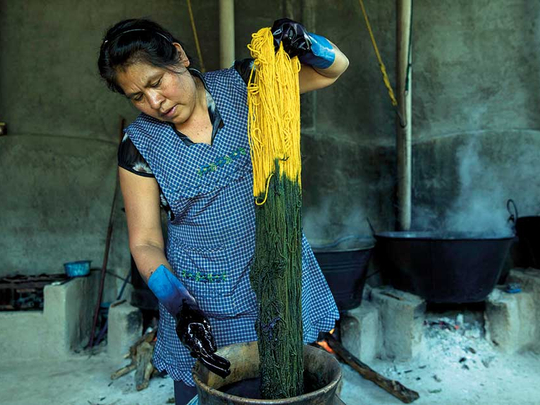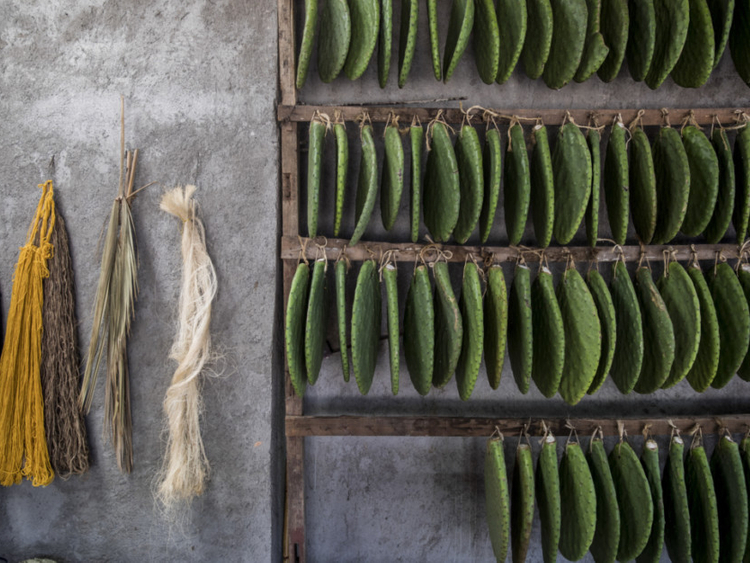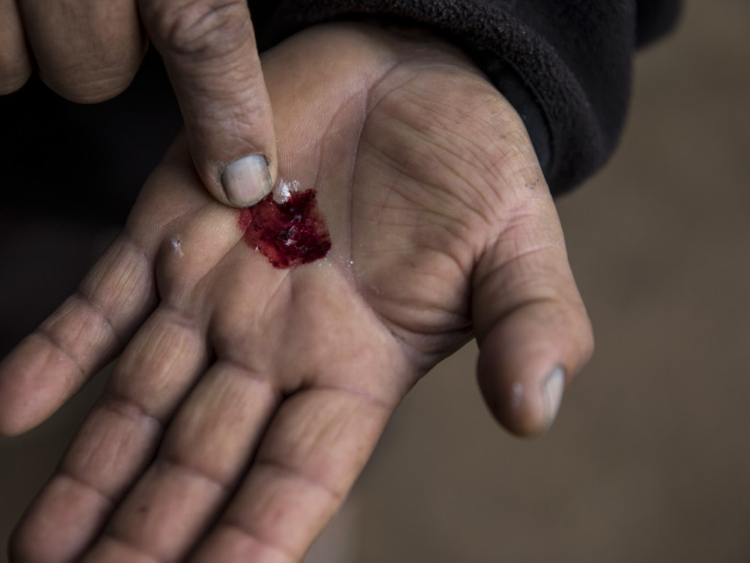
As a child, Porfirio Gutiérrez hiked into the mountains above the village with his family every autumn, collecting the plants they would use to make colourful dyes for blankets and other woven goods.
They gathered pericon, a type of marigold that turned the woollen skeins a buttercream colour; jarilla leaves that yielded a fresh green; and tree lichen known as old man’s beard that dyed wool a yellow as pale as straw.
“We’d talk about the stories of the plants,” Gutiérrez, 39, recalled. “Where they grew, the colours that they provide, what’s the perfect timing to collect them.”
Gregarious and possessed of an entrepreneurial spirit, Gutiérrez is descended from a long line of weavers. His father taught him to weave as a child; he even wove the backpack he took to school.
In Teotitlan del Valle, a small village near Oaxaca, known for its hand-woven rugs, he and his family are among a small group of textile artisans working to preserve the use of plant and insect dyes, techniques that stretch back more than 1,000 years in the indigenous Zapotec tradition.
Textile artists in many countries are increasingly turning to natural dyes, both as an attempt to revive ancient traditions and out of concerns about the environmental and health risks of synthetic dyes.
Natural dyes, though more expensive and harder to use than the chemical dyes that have largely supplanted them, produce more vivid colours and are safer and more environmentally friendly than their synthetic counterparts.
To be sure, natural pigments are not always benign. The plants they are extracted from can be poisonous, and heavy metal salts are often used to fix the colours to the fabric. The dyes fade more quickly from sun exposure than chemically produced colours, arguably rendering the textiles less sustainable.
But environmentalists have long worried about the damaging effects of the wide array of toxic chemicals — from sulphur and formaldehyde, to arsenic, copper, lead and mercury — routinely used in textile production.
Runoff from textile factories pollutes waterways and disrupts ecosystems worldwide. And long-term exposure to synthetic dyes — first discovered in 1856 by an English chemist, William Henry Perkin — has been linked to cancer and other illnesses.
“They are very toxic,” Gutiérrez said. “The more awareness you raise, the more artists are going to use natural dyes and stay away from heavily chemically dyed yarn.”
Teotitlan del Valle has long been a centre for weaving — according to one estimate, there are 2,000 or more looms in the village. In his book, “Oaxaca Journal”, Dr Oliver Sacks, the writer, neurologist and amateur botanist, described the village as having “almost a hereditary artisan class.”
“Virtually everyone in Teotitlan del Valle has a deep and detailed knowledge of weaving and dyeing, and all that goes with it — carding, combing the wool, spinning the yarn, raising the insects on their favourite cactuses, picking the right indigo plants,” Sacks wrote.
Most of the master weavers in Teotitlan are men. But until the Spanish arrived in the early 1500s, weaving in the village was done by women using back-strap looms, said Norma Schafer, who writes the blog Oaxaca Cultural Navigator and has studied the history of indigenous arts and crafts in the region.
The Spaniards, Schafer said, brought free-standing, frame-pedal looms and used them to reward villages that helped fight the Aztecs. Zapotec men in Teotitlan were taught how to use the devices.
Woven blankets and wraps eventually became the village’s main source of income. But it was Americans, travelling through the Oaxaca valley in the 1970s, who saw an opportunity to market the Teotitlan weavers’ colourful hand-woven throw rugs.
“They brought Navajo designs to the village,” Schafer said. “These then were sold at a lower cost to people decorating their houses in the Southwestern style.”
Increased demand led to higher production, with wholesalers distributing rug patterns and paying village weavers by the piece for rugs. Today, about 75 per cent of Teotitlan’s population of 5,600 is involved in some aspect of weaving.
“Every family has their own recipe, and every family does their dye process differently,” Schafer said.
The majority of those rugs are made using chemical dyes. By the time Gutiérrez was born in 1978, the ninth of 11 children, his family was using natural dyes only for personal items, such as blankets.
At 18, he left the village for the United States, working first in a fast-food restaurant and later as a manager of a concrete plant in Ventura, California. It was 10 years before he returned to Teotitlan to visit his family.
Thoroughly Americanised by that time, “it was a huge culture shock,” he recalled.
Leaning on the family loom while his father worked, he listened to stories about what life had been like in the village and how it had changed. Eventually he rediscovered a passion for weaving. And he realised that, just as he had forgotten the richness of his culture, the village, too, was slowly losing its age-old traditions.
“There was not much soul anymore,” he said. “These natural dyes were absolutely on the brink of extinction.”
Gutiérrez and his family decided to create their own weaving studio to create pieces using only natural dyes and to teach others how to do it.
His sister, Juana Gutiérrez Contreras, serves as dye master, combining seven or eight natural elements to produce more than 40 colours. Contreras’s husband, Antonio Lazo Hernandez, is also a master weaver and helps develop the textile designs.
Potassium alum, or potash, a mineral found in the mountains around Oaxaca, is used as a mordant, holding the dye to the yarn. In addition to plants gathered in the mountains, flora common in local gardens — zapote negro, marush and pomegranate, for example — are also used as sources for dye.
The indigo and cochineal pigments, however, are purchased from elsewhere. The anil plant grows primarily in the southern part of the state of Oaxaca. As for cochineal — a dye that coloured the red coats of British soldiers — tens of thousands of dried insects are needed to produce just 1 pound of dye.
So the studio buys the pigment from families who farm the prickly pear cactuses that host the parasitic insects. Only females produce the carminic acid that is responsible for the intense red colouring.
The dye is so harmless that the family uses it to water the garden, while the remaining plant material serves as mulch.
In Teotitlan, Gutiérrez is not the only artisan concerned with preserving Zapotec weaving traditions. Perhaps a dozen others in the village use natural dyes exclusively, and some train tourists in the techniques.
But Gutiérrez’s fluency in English and familiarity with the United States — he still lives much of the time in Ventura — have given him an opportunity to reach a wider audience.
His family is compiling a book of dye recipes, formulas passed down for centuries by word-of-mouth. And Gutiérrez has worked to expand traditional designs used by Zapotec weavers into new territory, for example, by combining wool with agave fibre, palm leaves — used for thousands of years to make mats for sleeping — or other natural materials.
“What my family and I are doing is continuing an art form and honouring the work that our ancestors started,” he said. “I think once people learn more about these processes, then they’ll support this market, and that’s how it will continue.”
–New York Times News Service
















